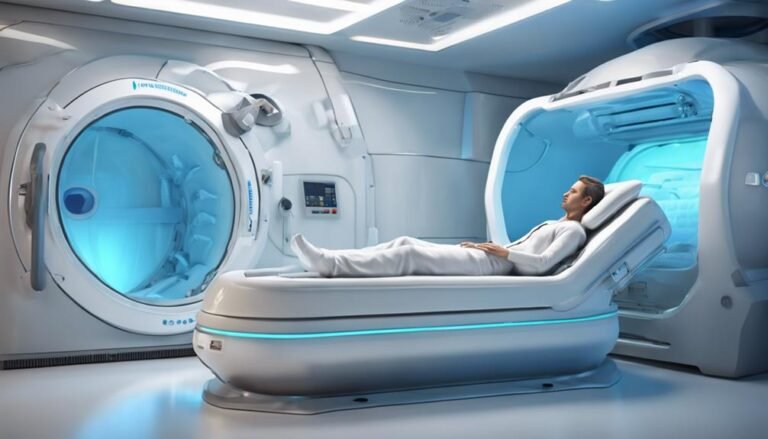Advanced Pain Management Techniques Review: Worth the Expense?
When deciding on advanced pain management techniques, it's important to weigh the benefits against the costs for best relief. Evaluating the cost-effectiveness of these advanced methods is essential. Innovative treatments show promising results, balancing efficacy and safety. Patient satisfaction and experience play crucial roles in pain management outcomes. Long-term assessments help optimize care and well-being beyond immediate relief. Consider how advanced techniques differ from conventional methods for improved outcomes. Making an informed decision based on treatment variances is significant. Uncover more insights into the worthiness of investing in advanced pain management techniques for enhanced quality of life and recovery.
Key Takeaways
- Cost-benefit analysis crucial for assessing worth
- Effectiveness and safety pivotal in decision-making
- Patient satisfaction and experience impact worth assessment
- Long-term outcomes evaluation essential for value determination
- Comparison with conventional methods aids in informed choices
Cost-Effectiveness of Advanced Techniques
When considering pain management options, evaluating the cost-effectiveness of advanced techniques is essential for making informed decisions about treatment. Advanced pain management techniques often come with a higher price tag, leading to concerns about the financial burden they may place on individuals seeking relief. Conducting a cost-benefit analysis becomes vital in determining whether the benefits of these advanced techniques outweigh the costs involved.
Given the rising costs of healthcare, understanding the financial implications of opting for advanced pain management techniques is paramount. While these innovative treatments may offer improved outcomes and faster recovery times, they can also present a significant financial burden for patients, particularly if not covered by insurance. Therefore, weighing the potential benefits against the costs through a thorough cost-benefit analysis is necessary to make sure that individuals are making financially sound decisions when choosing advanced pain management options.
Efficacy of Innovative Treatments
Exploring the effectiveness of cutting-edge treatments is essential in determining their impact on pain management outcomes. When evaluating innovative pain management techniques, two vital factors to take into account are effectiveness and safety. Effectiveness refers to the ability of a treatment to produce the desired results in reducing or alleviating pain, while safety emphasizes the importance of making sure that the treatment does not pose undue risks to the patient.
To better understand this concept, let's look at a comparison between traditional pain management methods and innovative treatments:
| Aspect | Traditional Methods | Innovative Treatments |
|---|---|---|
| Effectiveness | Provide relief for some patients | Show promising results in clinical trials |
| Safety | Well-established safety profile | Undergoing rigorous testing for safety and efficacy |
| Cost | Generally more affordable | Higher initial cost but potential long-term savings |
Analyzing these aspects can help you weigh the benefits and risks of adopting innovative pain management techniques. It's essential to strike a balance between effectiveness and safety to ensure optimal outcomes for patients.
Patient Experience and Satisfaction
Considering the diverse nature of pain experiences, understanding and addressing patient satisfaction is essential in enhancing pain management outcomes. From the patient perspective, the effectiveness of pain relief techniques greatly influences their overall experience and satisfaction with the care received. Patients often seek not only a reduction in pain intensity but also improvements in their quality of life, emotional well-being, and ability to engage in daily activities. Hence, healthcare providers must prioritize not just the technical aspects of pain management but also the holistic experience of the patient.
Patient satisfaction isn't solely determined by the level of pain relief achieved but also by the communication and empathy demonstrated by healthcare professionals. Patients value being heard, feeling understood, and having their concerns validated throughout the treatment process. Moreover, the environment in which care is delivered plays a critical role in shaping the patient's overall experience. Creating a supportive and compassionate setting can have a substantial impact on patient satisfaction and contribute to better pain management outcomes.
Long-Term Outcomes Assessment
To thoroughly evaluate the effectiveness of pain management techniques, examining long-term outcomes is essential for understanding the sustained impact on your well-being.
Long-term outcomes assessment explores two vital aspects: quality of life and functional independence. Quality of life encompasses various factors such as pain levels, emotional well-being, social interactions, and overall satisfaction with daily activities. By evaluating quality of life over an extended period, healthcare providers can gauge the holistic impact of pain management techniques on your physical, mental, and emotional health.
Functional independence focuses on your ability to perform daily tasks, engage in activities you enjoy, and maintain a sense of autonomy. Evaluating functional independence in the long term provides insight into how well the pain management strategies support your overall functionality and independence.
Together, these evaluations provide a thorough view of how pain management techniques influence your well-being beyond immediate relief, guiding healthcare providers in optimizing your long-term care.
Comparison With Conventional Pain Management
When considering pain management techniques with conventional methods, it's crucial to understand the nuanced differences in their approaches and outcomes for effective decision-making in your care.
When evaluating cost comparison, conventional pain management often involves medications, physical therapy, and occasional interventions like injections or surgeries. These treatments can accumulate significant costs over time, especially if they require long-term maintenance.
On the other hand, advanced pain management techniques may initially seem more expensive due to innovative technology or specialized procedures. However, these techniques often aim for more targeted and long-lasting results, potentially reducing the need for frequent appointments and medication refills. Additionally, the treatment comparison shows that advanced techniques may offer a quicker recovery time and improved quality of life, which could lead to indirect cost savings in the long run.
When weighing these factors, discussing with your healthcare provider the pros and cons of each approach based on your specific condition and preferences becomes vital. By understanding the cost and treatment differences, you can make an informed decision that aligns with your goals for pain management.
Conclusion
To sum up, investing in advanced pain management techniques may seem costly, but the benefits far outweigh the expense. The innovative treatments offer remarkable efficacy, leading to improved patient satisfaction and long-term outcomes.
When compared to conventional methods, the advanced techniques provide a superior level of care that can truly be described as a game-changer in pain management.
So, go ahead and take the leap – your comfort and well-being are worth it!







